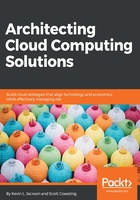
Implementation strategy
To illustrate, there are three main categorical ways to consume IT products and services. The first is in-house. In-house refers to a typical enterprise implementation, where the organization pays for ownership of all applicable resources. The enterprise also employs the required operations staff to operate the deployed solutions. In this model, the enterprise has complete and total control of IT governance.
The second, managed service provider (MSP), is an arrangement where the enterprise contracts with an outside service provider to provide and/or manage IT resources. In this model, the enterprise retains some level of IT governance control by negotiating and enforcing a binding contract known as a service level agreement. The enterprise also funds all the MSP incurred costs plus a mutually agreed to profit. This option can be cheaper than the traditional data center due to economies of scale. If the MSP is more efficient and/or more automated, the same desired outcome may be less expensive but will require some change to governance as some responsibilities will be shifted from in-house enterprise resources to the service provider.
The third option uses a cloud service provider (CSP). The CSP funds all hardware and software. The CSP also pays the salaries and benefits for the required operations staff. The required IT function is consumed by the enterprise completely as-a-service. In this model, the CSP has complete and total control of IT governance.
The following diagram here illustrates a few differences between the outsourcing models, MSP, and CSP. When choosing IT strategies, associated governance plans must also adapt to service models, deployment models, and implementation options:
